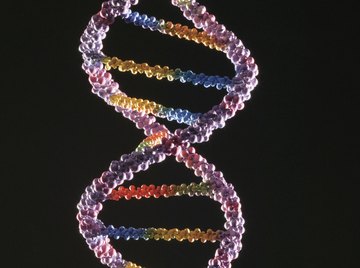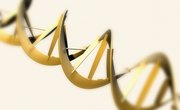
Deoxyribonucleic acid, or DNA, contains the genetic information handed down from one generation to the next. In your body, each cell contains at least one set of your entire genetic complement, housed in 23 different chromosomes. In fact, most of your cells have two sets, one from each parent. Before a cell can divide, it must accurately replicate its DNA so that each daughter cell receives complete and correct genetic information. DNA replication includes a proofreading process that helps to ensure accuracy.
DNA Structure
DNA is a long molecule with a backbone of alternating sugar and phosphate groups. One of four nucleotide bases -- adenine (A), guanine (G), cytosine (C) and thymine (T) -- hangs off each sugar unit. The sequence of the four bases creates the genetic code for manufacturing proteins. The nucleotides of two DNA strands bind to each other to form the familiar double helix structure. The base pairing rules require that A only bind with T and C only bind with G. The cell must obey these pairing rules during replication to maintain accuracy and avoid mutations.
Replication
Replication is semi-conservative: newly replicated helices contain an original strand and a newly synthesized one. The original strand serves as a template for the creation of the new strand. Helicase enzymes unzip the double helix structure to expose the two template strands. The enzyme DNA polymerase is responsible for reading each nucleotide on a template strand and adding the complementary base on the elongating new strand. For example, when the polymerase encounters a G base on a template strand, it adds to the new strand a sugar-phosphate unit containing a C base.
Proofreading
DNA polymerase is a remarkable enzyme. Not only does it assemble new DNA strands one base at a time, it also proofreads the new strand as it proceeds. The enzyme can detect an incorrect base on the new strand, back up one sugar unit, snip out the bad base, replace it with the correct base and resume replicating the template strand. The ability to snip out the incorrect base, called exonuclease activity, is built into the DNA polymerase complexes. Proofreading results in an accuracy rate of about 99 percent.
Mismatch Repair
Accurate replication is important enough that cells have evolved a secondary error correction mechanism called DNA mismatch repair to fix the mistakes that DNA polymerase misses. The repair machinery detects mismatches by inspecting the DNA helix structure for deformities. The Mut family of enzymes detects a mismatch, identifies the newly copied strand, finds a suitable location to cleave the strand and removes the portion containing the mismatch. DNA polymerase then resynthesizes the removed portion. Unlike with the single-base repair that DNA polymerase performs while proofreading, the mismatch repair mechanism may replace thousands of bases to make one repair.
References
About the Author
Based in Greenville SC, Eric Bank has been writing business-related articles since 1985. He holds an M.B.A. from New York University and an M.S. in finance from DePaul University. You can see samples of his work at ericbank.com.
Photo Credits
Comstock/Stockbyte/Getty Images
